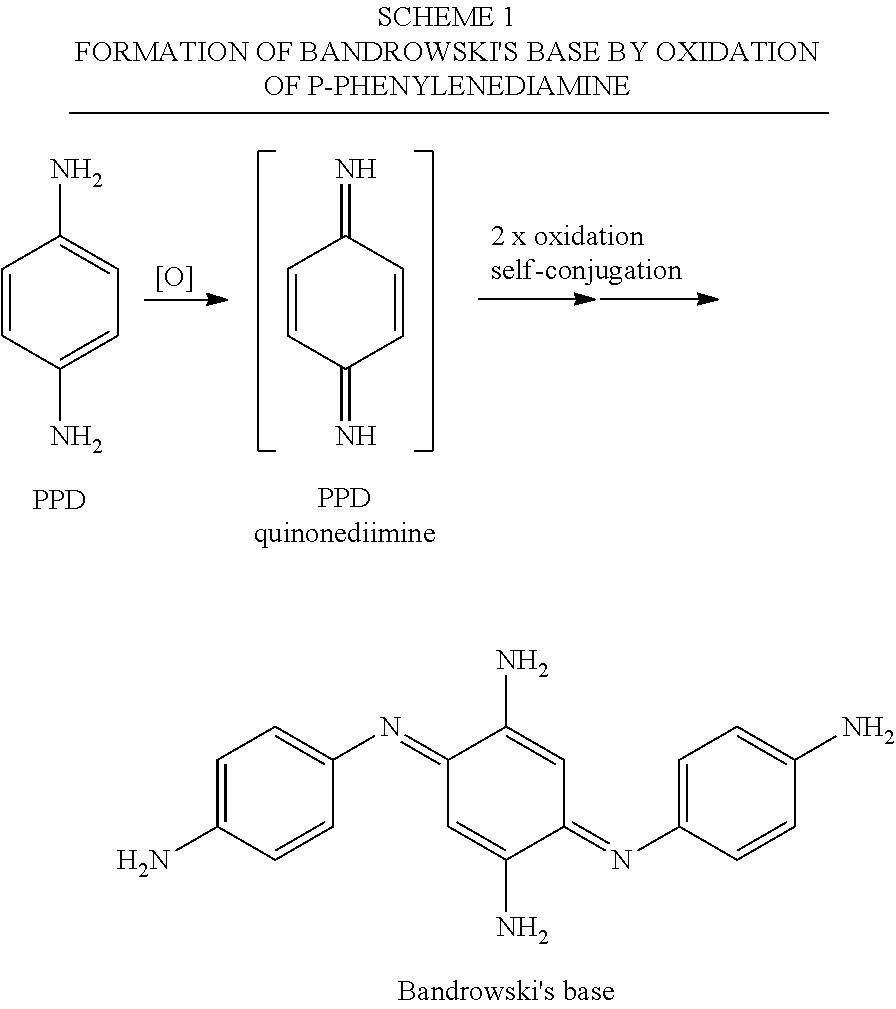Catalysed Dye Systems
a dye system and catalytic technology, applied in the direction of dyeing process, application, hair cosmetics, etc., can solve the problems of potential toxicological effects, non-sustainable sources of available hair colorants, and people applying colorants to their hair, so as to avoid the use of potentially harmful effects
- Summary
- Abstract
- Description
- Claims
- Application Information
AI Technical Summary
Benefits of technology
Problems solved by technology
Method used
Image
Examples
example 1
Dyeing of Hair
[0063]Solutions of dye precursor (100 mg) and ZrOCl2 (100 mg) in water (20 ml) were prepared and added to glass jars. Into each jar was suspended a bleached blonde hair swatch. Hydrogen peroxide (0.1 ml) was added, the jars sealed, and the mixtures shaken for 60 minutes, after which the swatches were removed, rinsed in warm water and air dried. The results are summarised in Table 1.
TABLE 1Colours observed when dyeing hair swatches with various dyeprecursors and ZrOCl2 catalyst according to the inventionPrecursorColourp-AminophenolBrowno-AminophenolBrown1,4-DihydroxynaphthaleneOrange / redIsatinYellowp-PhenylenediamineBlackm-AminophenolRed / brown3-MethylcatecholBrownCatecholBlondep-Amino-o-cresolOrange / red
example 2
Dyeing of Hair
[0064]Solutions of m-aminophenol (30 mg) in water (10 ml) were prepared and added to glass jars. Catalyst (30 mg) was added, and a bleached blonde hair swatch suspended in each jar. Hydrogen peroxide (0.1 ml) was added, the jars sealed and the mixtures shaken for 60 minutes, after which the swatches were removed, rinsed in warm water and air dried. The results are summarised in Table 2.
TABLE 2Colours observed when dyeing hair swatches using m-aminophenol dyeprecursor and various catalysts according to the inventionCatalystColourBLANKNo colourVO(OiPr)3BrownVOSO4BrownMnO2GreyMnCl2•xH2OBrownNH4VO3BrownV2O5BrownAZG-370 (AluminiumBrownZirconium TetrachlorohydrexGlycine Complex)AZP-908 (AluminiumBrownZirconium TetrachlorohydrexGlycine Complex)REZAL 67 (AluminiumBrownZirconiumPentachlorohydrate Solution)ZIRCALEM G36L (AluminiumBrownZirconium TetrachlorohydrexGlycinate Solution)
example 3
Dyeing of Hair
[0065]Solutions of p-amino-o-cresol (30 mg) in water (10 ml) were prepared and added to glass jars. Catalyst (30 mg) was added, and a bleached blonde hair swatch suspended in each jar. Hydrogen peroxide (0.1 ml) was added, the jars sealed and the mixtures shaken for 60 minutes, after which the swatches were removed, rinsed in warm water and air dried. The results are summarised in Table 3.
TABLE 3Colours observed when dyeing hair swatches usingp-amino-o-cresol dye precursor and various catalystsaccording to the inventionCatalystColourBLANKNo colourVO(OiPr)3Orange / brownVOSO4Orange / brownMnO2BrownMnCl2•xH2OOrange / brownNH4VO3Orange / brownV2O5BrownAZG-370 (AluminiumOrangeZirconium TetrachlorohydrexGlycine Complex)AZP-908 (AluminiumOrangeZirconium TetrachlorohydrexGlycine Complex)REZAL 67 (AluminiumOrangeZirconiumPentachlorohydrate Solution)ZIRCALEM G36L (AluminiumOrangeZirconium TetrachlorohydrexGlycinate Solution)
PUM
| Property | Measurement | Unit |
|---|---|---|
| temperatures | aaaaa | aaaaa |
| pressures | aaaaa | aaaaa |
| temperatures | aaaaa | aaaaa |
Abstract
Description
Claims
Application Information
 Login to View More
Login to View More - R&D
- Intellectual Property
- Life Sciences
- Materials
- Tech Scout
- Unparalleled Data Quality
- Higher Quality Content
- 60% Fewer Hallucinations
Browse by: Latest US Patents, China's latest patents, Technical Efficacy Thesaurus, Application Domain, Technology Topic, Popular Technical Reports.
© 2025 PatSnap. All rights reserved.Legal|Privacy policy|Modern Slavery Act Transparency Statement|Sitemap|About US| Contact US: help@patsnap.com



